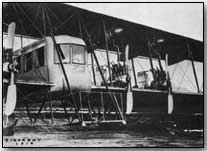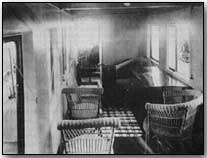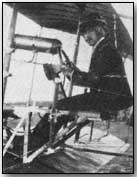The War in the Air - Bombers: Russia
 Long before his pioneering work on helicopters, Igor Sikorsky became
interested in multi-engined aircraft. This interest was sparked in
1911 after he nearly crashed when an insect caught in the carburettor of his
single engined plane.
Long before his pioneering work on helicopters, Igor Sikorsky became
interested in multi-engined aircraft. This interest was sparked in
1911 after he nearly crashed when an insect caught in the carburettor of his
single engined plane.
In 1913 he built the world's first four engined airplane, the "Grand" and he followed this experimental aircraft with the "Ilya Murometz" in late 1913. Named after a medieval Russian folk hero, the Ilya Murometz was an astonishingly sophisticated plane for one built a mere ten years after Kitty Hawk.
Designed as a civil transport, the Murometz featured a number of extraordinary features: an enclosed cabin capable of holding 16 passengers; heating provided by channelling exhaust gases through radiator pipes; electric lighting powered by an on-board wind generator; there was even an on board toilet. Sikorksy even provided for in-flight access to the engines - a sign of his lack of faith, and their general unreliability.
The Murometz was produced by the "Russo-Baltic Wagon Company." Its director, Mikhail Shidlovsky, was an ex-navy man with connections to the Russian military. He managed to convince the Imperial Russian Air Force (IRAF) to utilize the Murometz for reconnaissance and bombing purposes.
An order was immediately placed for some planes, and in December 1914 Shidlovsky himself, with the rank of Major General, took over command of the "Squadron of Flying Ships", the Escadra Vozdushnykh Korabley, known as the EVK. Shidlovsky, apparently as shrewd a businessman as Fokker, remained the sole manufacturer. Nobody in pre-soviet Russia seems to have considered this unethical.
The first couple of months of the EVK were almost their last. The pilots were unused to flying such large aircraft, the ground crew were unable to maintain them, and the Murometz rapidly gained a poor reputation. Shidlovsky brought Sikorsky to his base and together they managed to overcome the teething problems.
 The
EVK's first operations began in late February of 1915. At this stage
they only had one operational aircraft, and it carried out the EVK's first
reconnaissance sortie, which was followed shortly after by a pair of bombing
raids against Villenburg station.
The
EVK's first operations began in late February of 1915. At this stage
they only had one operational aircraft, and it carried out the EVK's first
reconnaissance sortie, which was followed shortly after by a pair of bombing
raids against Villenburg station.
In these two raids nineteen men and a number of horses were killed, the station along with rolling stock was destroyed, and there was widespread panic. After dropping the bombs the crew took reconnaissance photos.
The success of their early missions was so great that the EVK was ordered to report directly to the Stavka (Supreme High Command of the Russian Military). This was in keeping with Shidlovsky's vision of an independent force operating along lines similar to that of a naval fleet. As the war progressed the EVK developed its own photographic unit for the development and distribution of reconnaissance photos, and it also had its own meteorological unit and flight school.
The EVK's success also brought orders for more planes. Sikorsky continued to develop the Murometz until Russia withdrew from the war in 1917. These later variations were designed with military, as opposed to civilian, requirements in mind.
As a bomber the Murometz was far ahead of its time. It could carry a bomb load of up to 800kg (1760lb), with a range of approximately 500km (310 miles). (The exact performance figures differ from variation to variation.) Equipped with bomb sights, the Murometz was reputed to be more than 60% accurate. The EVK flew both reconnaissance and bombing missions, flying more than 400 bombing sorties.
They flew in all the Russian theatres of conflict, bombing mainly transportation, supply and communications targets. The planes were well known to the Germans, who set up special anti-aircraft batteries when they knew that the EVK was operating in the area. Often these batteries themselves became prime targets of the EVK.
The heaviest bomb the Murometz ever carried was 240 kg (530lb), but usually it carried a mix of explosive and incendiary bombs. It was slow, but sturdy and heavily armed. Its unprecedented size was also an advantage, as it led German pilots to misjudge their distance from it.
 The
Murometz holds a unique record for any bomber in any conflict: it shot down
more enemy fighters than were lost to enemy fire. While only one
Murometz was ever lost to enemy aircraft (on the 26th of September 1916), at
least ten fighters succumbed to her defensive fire. It is no wonder
the German pilots nicknamed the plane the "Hedgehog".
The
Murometz holds a unique record for any bomber in any conflict: it shot down
more enemy fighters than were lost to enemy fire. While only one
Murometz was ever lost to enemy aircraft (on the 26th of September 1916), at
least ten fighters succumbed to her defensive fire. It is no wonder
the German pilots nicknamed the plane the "Hedgehog".
One other Murometz crashed over Russian territory, probably as a result of enemy anti-aircraft fire, and one more was lost due to pilot error.
This is not to say that the planes did not suffer severe battle damage, but Sikorsky had designed an extremely tough aircraft. More than once a Murometz returned to base on two engines only. Sometimes the planes had to be scrapped after bringing the crew back safely. Suffering severe supply shortages throughout the war, the EVK cannibalized the scrapped aircraft.
The main problem with the Murometz was with the engines. The pre-war Murometz was designed to use German-built engines, which obviously were not available. Sikorsky experimented with a range of Russian and British engines, but never achieved the desired level of performance. These problems, together with the low level of Russian manufacturing, meant that only 75 of this outstanding aircraft were produced during the war.
Shidlovsky decided, after the revolution, that he had no future in Russia, and he convinced Sikorsky to leave also. Shidlovsky, together with his son, was captured trying to cross the border into Finland. They were shot. Sikorsky was luckier. From Murmansk he managed to escape by ship to London.
Article contributed by Ari Unikoski
Next - Bombers - Italy
A bunker comprised a fortification largely built below ground level.
- Did you know?
